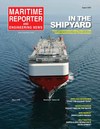
Page 50: of Maritime Reporter Magazine (August 2021)
The Shipyard Annual
Read this page in Pdf, Flash or Html5 edition of August 2021 Maritime Reporter Magazine
TECH FEATURE Ballast water management systems
Watch the interview with
Rudy Mes & Giles Candy @ Bit.ly/3fq6c1V
All photos courtesy Scienco/Fast
Inset photos above [L to R]: InTank Dosing Module and Circulation Pump; InTank Bulk Chemical and DeChlor Modules;
InTank Dosing Module in existing Deckhouse; and InTank EC Module and DeChlor Unit.
Once treatment is complete, you then control your neutraliza- of days. When we sign a project contract with the owner, then tion. So you have neutralized the water before discharge. If we start the application engineering, which is determining there is an issue (with the system), you’re at sea, so hopefully (things like) how big the circulation pumps are going to be, you can fx that issue and complete treatment without impact- how big the feed pumps are going to be, how many nozzles ing the commercial operation of the vessel. It gives so much are in each tank to get good circulation. That process takes more control to the operation of the vessel. about two weeks. After that, we have integration engineering, looking at the tying points to the existing ballast system, in-
Ship owners want to spend as little time as pos- tegration with the existing automated valves on board (and sible in the shipyard, and the retroft of BWMS pipe runs throughout the ship). That’s a process that normally on existing ships can be an engineering head- takes about eight weeks. ache. What is a typical timeframe and process to
Normally, when we have a signed contract, the minimum get the InTank system installed?
time we need to send it out is about 16 weeks. Our production
Rudy Mes From the frst contact we ask a lot of questions capacity is not an issue; it’s more the third party (ie. pump and about the vessel specifcs: ballast water capacity, number of valve manufacturers) that puts a limitation on the availability tanks, etc., and then we start calculating three different op- of the system for the vessel owner.
tions of the system that we could offer, options to consider dif- ferent treatment times, different operational costs and initial Looking at the system holistically, are there any advantages for the shipyard?
investment costs. Based on the readiness of the vessel owner to share information, this process can be fnished in a couple Rudy Mes Our system is relatively small, about a 7 sq. m. 50 Maritime Reporter & Engineering News • August 2021

 49
49

 51
51
